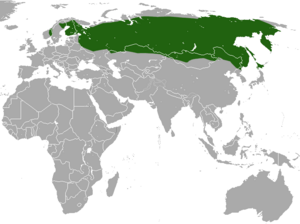Eurasian least shrew facts for kids
Quick facts for kids Eurasian least shrew |
|
|---|---|
 |
|
| Specimen exhibited in the National Museum of Nature and Science, Tokyo, Japan. | |
| Conservation status | |
| Scientific classification | |
| Genus: |
Sorex
|
| Species: |
minutissimus
|
 |
|
| Eurasian least shrew range | |
The Eurasian least shrew (Sorex minutissimus) is a tiny mammal. It's also known as the lesser pygmy shrew. This amazing creature is the second-smallest mammal in the world by weight! Only the Etruscan shrew is smaller.
Contents
What Does the Eurasian Least Shrew Look Like?
This tiny shrew weighs only about 1.2 to 4 grams. That's lighter than a paperclip! Its body is less than 4 centimeters (about 1.5 inches) long. It also has a tail that is about 2.5 centimeters (1 inch) long.
Its back is usually brown, and its belly is light grey. There's a clear line where these two colors meet. The color of its back changes with the seasons. It can be chocolate brown in summer and a lighter brown in winter. Its tail also has two colors, just like its body. The end of its tail has a small tuft of dark brown hair. The shrew's feet are the same light color as its belly, but its heels are brown.
Where Do Eurasian Least Shrews Live?
The Eurasian least shrew lives in the northern taiga region. The taiga is a huge forest area with lots of conifer trees. You can find these shrews all across Siberia. They also live in northern Europe, including Finland, northern Sweden, and parts of Norway. You can even find them on the islands of Sakhalin and Hokkaidō in Asia.
These shrews can live in many different places. They are found in both evergreen and deciduous forests. They also live in open fields and near the edges of bogs (wetlands). It seems there aren't many of them in any one place. Scientists might not find them often because they are so small. Their tiny size helps them escape many traps used in surveys.
How Do Eurasian Least Shrews Behave?
It can be hard to spot a Eurasian least shrew because it's so small. Also, it tends to hide away from people. Like most shrews, it mainly eats insects. But it will also eat dead animals (called carrion) or any other protein it finds. Sometimes in winter, it might even look for food inside buildings.
Because it's such a small mammal, the Eurasian least shrew has a very fast metabolic rate. This means its body burns energy very quickly. So, it needs to eat often to avoid starving. In labs, these shrews have been seen eating 120 meals a day! They can eat three to four times their own weight every single day. The Eurasian least shrew is active all day and night. It takes short naps, usually lasting 10 to 50 minutes.
This shrew is also a good swimmer. In labs, some shrews even seem to enjoy playing in water. Their small size also makes them amazing climbers. They have been seen climbing up the smooth inside corner of a glass tank! Their eyesight isn't very good. However, they have excellent hearing. Eurasian least shrews make many sounds. But much of their communication is in frequencies that humans cannot hear.
Reproduction and Life Cycle
Female Eurasian least shrews usually have one or two groups of babies each year. Each group, called a litter, typically has 3 to 6 baby shrews. Scientists don't know much about how long these shrews live in the wild. But some have lived for over 2.5 years in labs.
How to Identify a Eurasian Least Shrew
The Eurasian least shrew can sometimes be confused with the Eurasian pygmy shrew (S. minutus). The pygmy shrew is a bit larger and often lives in the same areas. You can tell the two species apart by looking at their tails and feet. The least shrew's tail and feet are much shorter compared to its body size.


